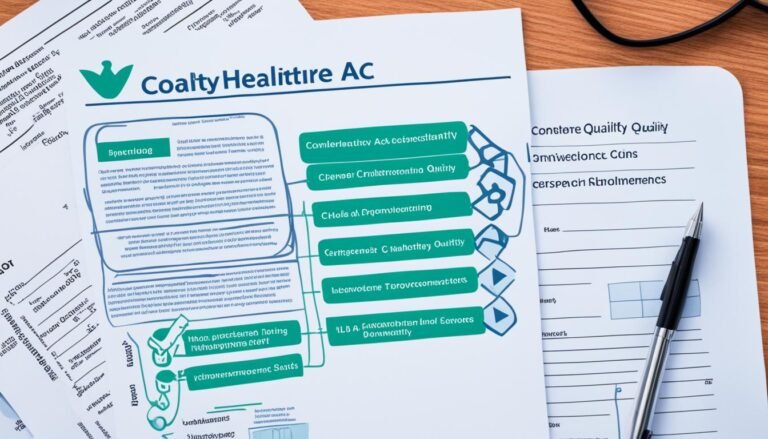OSHA Regulations – Your Guide to Workplace Safety
Every year, more than 4,600 workers die at work. Around 3 million get injured, says the Occupational Safety and Health Administration (OSHA). These high numbers show how crucial OSHA rules are for making workplaces safer. They cover everything from safety tips to full OSHA rules. This guide will help make sense of OSHA standards and safety steps. It aims to inform both employers and employees about OSHA rules. Knowing these can greatly reduce injuries and deaths at work.
OSHA rules show the agency’s strong effort to prevent dangerous work environments. They help build a culture that values workers’ well-being. This guide is here to help. Whether you are a boss improving workplace safety or a worker learning about your rights. This information is your guide through the complex OSHA rules. With the right knowledge and tools, making a safe workplace is doable.
Key Takeaways
- Understanding OSHA regulations is crucial for preventing workplace injuries and fatalities.
- Employers must create a workplace that adheres to OSHA standards and safety protocols.
- OSHA compliance requirements are not mere suggestions—they are legal obligations that protect workers’ occupational health.
- Implementing workplace safety guidelines is foundational to cultivating a safe and healthy work environment.
- Occupational safety laws and workplace health regulations vary across industries, making tailored compliance strategies essential.
- Workers have defined rights under OSHA guidelines, empowering them to advocate for their safety without fear.
Understanding the Role of the Occupational Safety and Health Administration (OSHA)
The Occupational Safety and Health Administration (OSHA) is key in keeping America’s workers safe and healthy. It sets and enforces safety standards and offers training. OSHA works to stop workplace injuries and illnesses. It’s important to know how OSHA helps make jobsites safer for everyone.
Origin and Purpose of OSHA
OSHA’s beginning came from the need for safer work conditions across the nation. The Occupational Safety and Health Act of 1970 created the agency. Its main goal is to make sure workers have a safe environment, by setting rules and doing inspections.
The OSH Act: A Milestone in Worker Safety
The Occupational Safety and Health Act (OSH Act) was a big change for worker safety in various sectors. It not only started OSHA but also pushed employers to lessen job hazards. The OSH Act remains crucial in making workplaces safer for everyone, urging both employers and employees to work together towards this goal.
Employer Responsibilities Under OSHA Regulations
Making sure the workplace is safe is a key job for employers, and it’s required by OSHA regulations. These rules help protect workers and keep their environment free from dangers. It’s important for employers to do several things to ensure health and safety at work.
To understand these important duties better, let’s look at the main tasks employers need to do. They need to check the workplace often, provide the right safety gear, offer training, and keep everyone informed about safety rules.
- Conducting a thorough analysis of all operations to identify potential hazards and taking measures to eliminate them.
- Ensuring that all tools and machinery meet safety standards and are maintained regularly to prevent malfunctions or accidents.
- Providing employees with protective gear that’s necessary to prevent injuries in case of accidents.
- Implementing a robust training program that educates employees on safe work practices and emergency response procedures.
- Establishing clear and effective lines of communication to ensure employees are well-informed about their rights and responsibilities under OSHA regulations.
By taking these steps, employers can make a big plan for workplace safety. This helps them follow OSHA regulations and build a workplace where safety is key.
| Employer Responsibility | Relevance to OSHA Compliance |
|---|---|
| Hazard Detection and Prevention | Direct compliance with OSHA standards to identify and mitigate risks. |
| Maintenance of Tools and Machinery | Ensuring functionality and safety according to regulatory requirements. |
| Distribution of Safety Gear | Protecting employees from potential hazards inherent to workplace tasks. |
| Employee Safety Training | Education that aligns with OSHA’s guidelines for safe operational procedures. |
| Communication of Safety Protocols | Upholding OSHA’s provision for employee awareness of safety standards. |
In summary, employer responsibilities go beyond just following OSHA regulations. They also need to actively promote a culture of safety and compliance. This shows a true commitment to both workplace safety and meeting regulatory standards.
The Importance of Compliance with OSHA Standards
Ensuring OSHA compliance is more than following the law. It shows a promise to keep workplaces safe and protect employees. The value of following OSHA standards goes way beyond just avoiding fines. It’s about valuing workers and using OSHA rules to do so. Being fully compliant is key to a productive, trusted organization.
- Minimizes the risk of workplace accidents and injuries
- Boosts employee happiness and job satisfaction
- Avoids costly legal problems and fines
- Makes the company look good to others
- Leads to better insurance rates with a good safety record
Ignoring OSHA standards can lead to big problems:
- Big fines and disrupting work
- More workers’ compensation claims
- Less trust and keeping of employees
- Harm to brand and market standing
OSHA compliance is a key part of management. It needs focus, resources, and always getting better.
| Benefit of Compliance | Consequence of Non-Compliance |
|---|---|
| Improved worker safety and health | Increased accidents and health issues |
| Protection from fines and legal issues | Money penalties and legal problems |
| Seen as a responsible employer | Loss of trust from employees and clients |
| Lower insurance costs | More expensive insurance fees |
| Better work productivity | Delays in work and lost productivity |
In conclusion, being aware of and sticking to OSHA standards is crucial for companies. It’s important for keeping workplaces safe and following rules. Doing this is a good investment. It protects workers, strengthens a company’s good name, and shows it as a responsible industry member.
An Overview of OSHA Workplace Safety Guidelines
Every employer must keep their employees safe. Following OSHA workplace safety guidelines creates a safe and aware culture. It’s crucial to spot workplace hazards early and share safety procedures. This helps keep everyone safe and operations smooth.
Identifying Recognized Hazards
Finding workplace dangers is the first step to reduce risks. OSHA helps employers look for and evaluate these dangers. Things like the type of work, specific industry risks, and past incidents matter here. Spotting hazards early helps prevent safety problems before they start.
Communicating Safety Procedures to Employees
Good communication is key to safety. It’s not just about telling workers of dangers but also training them for emergencies. It includes evacuation plans and how to handle equipment safely. Ongoing training helps employees understand safety procedures well. This makes them better at avoiding dangers at work.
OSHA guidelines say you must have signs and documents that show risks. Signs and colors warn employees of dangers around them.
The table below shows how to spot dangers and tell employees about them:
| Hazard Identification | Communication Strategies |
|---|---|
| Work area inspections | Safety signs & warnings |
| Employee feedback collection | Training sessions |
| Incident investigations | Manuals & instruction guides |
| Equipment and process reviews | Regular updates & briefings |
By using these guidelines, companies follow the law and help keep workplaces safe from injuries.
Best Practices for Maintaining OSHA Compliance
Implementing OSHA compliance best practices is key to creating a safe work setting. It boosts productivity and ensures regulatory alignment. These practices include safety training, hazard assessments, detailed record-keeping, and strong communication about workplace safety.
Following OSHA regulations is crucial. It helps employers avoid fines and, more importantly, protects their employees’ health. Now, let’s look at actions to ensure regulatory compliance and improve workplace safety.
- Consistent Safety Training: Give your employees the knowledge to dodge workplace hazards with regular training.
- Ongoing Hazard Assessments: Keep ahead of dangers by regularly checking the workspace and addressing risks quickly.
- Effective Record-Keeping and Reporting: Keep up-to-date logs of safety incidents, training, and compliance checks.
- Establishment of a Hazard Communication Program: Make sure all employees know about possible risks and how to handle them safely.
Sticking to these best practices builds a strong workplace safety culture. This culture not only meets standards but also makes a work environment where employees feel safe and appreciated.
| Safety Component | Action Steps | Benefits |
|---|---|---|
| Employee Training | Conduct quarterly safety workshops | Cultivates a safety-first mindset, reduces incidents |
| Hazard Assessment | Perform monthly safety audits | Proactive identification and resolution of risks |
| Record-Keeping | Utilize digital tracking systems | Streamlines incident reports, ensures data integrity |
| Hazard Communication | Develop clear, accessible safety documentation | Empowers employees with necessary hazard knowledge |
Additionally, promoting a safety culture where employee feedback is valued strengthens a firm’s safety practices and compliance. By integrating these strategies, a company makes safety a core part of its values. This leads to a resilient, healthy, and productive team.
Comprehensive Guide to OSHA Compliance Requirements
Starting to comply with OSHA can seem tough, but it’s easier when you break it down. Focus on training, keeping records, reporting, and talking about it. These steps help keep workplaces safe, productive, and free from fines. Let’s dig into these key compliance areas.
Safety Training and Education
Safety training is crucial, not just to meet OSHA requirements, but to empower workers. Training should match workplace hazards and employee roles. This means everyone learns to stay safe and handle emergencies. Continued learning makes safety a shared goal at work.
Record Keeping and Reporting
Keeping detailed records and reporting is essential for OSHA compliance. Logs of injuries, illnesses, and incidents help identify patterns and areas to improve. Good records help comply with laws and prevent future problems.
Hazard Communication Program Implementation
An effective hazard communication program is key for OSHA compliance. It involves clearly informing employees about chemical dangers. This includes labels, safety data sheets, and training. A strong program encourages open discussions on hazards and safety practices.
By focusing on training, record keeping, reporting, and hazard communication, companies can build a strong support system. This system fulfills OSHA’s mission to keep workers safe. It blends safety training and hazard communication into every workday.
Worker Rights and Protections Endorsed by OSHA
Knowing about worker rights and protections against retaliation is key for a fair workplace. OSHA offers guidelines to ensure safety and fairness in various jobs. This gives workers the comfort of knowing they are protected.
Understanding Worker Entitlements and Protections
OSHA worker protections are more than just rules; they respect workers’ dignity. Teaching workers about their safety rights helps them feel secure. They know their health and safety come first.
Exercising Rights Without Fear of Retaliation
A vital right under OSHA is protection against unfair punishment. This means people can report safety issues without fear of losing their job. It highlights that safety is always most important.
| Worker Right | Details | OSHA Reference |
|---|---|---|
| Right to a Safe Workplace | Guarantees a work environment free from recognized hazards | General Duty Clause, Section 5(a)(1) |
| Right to Training | Access to training on health and safety related to specific job roles | 29 CFR 1926.21(b)(2) |
| Right to Report Injuries | Ability to report work-related injuries and illnesses | 29 CFR 1904 |
| Right to File a Complaint | File a complaint to OSHA to inspect their workplace if believed to be unsafe | OSH Act of 1970, Section 8 |
| Protection Against Retaliation | Protection from being fired or discriminated against for exercising safety and health rights | OSH Act of 1970, Section 11(c) |
Preventative Strategies for Occupational Health
Using preventative strategies at work is key to boost occupational health and keep workplace health and wellness strong. Employers have many health and safety actions to pick from. These can greatly lower the chance of getting sick or hurt from work. Caring for the physical and mental health of employees is now a crucial part of how companies operate.
A good preventative strategy looks at everything. It cares not just about the job’s physical side but also the mental stress and employees’ overall health. Adding health and safety measures like breaks, workshops on handling stress, and desks that protect your posture can stop burnout and injuries to muscles and joints.
“The health of the employee is the health of the organization. By taking proactive steps, we ensure a more dynamic, engaged, and resilient workforce.”
Here are main ways to keep workers healthy and safe:
- Ergonomic assessments make workspaces fit each person, reducing harm and preventing injuries.
- Frequent health checks help spot health problems early.
- Wellness programs for employees that offer exercise, advice on eating well, and support for mental health.
- Mental health tools like having a counselor at work or app subscriptions for meditation.
Health and Safety Measures: Building health and safety rules is crucial for better occupational health over time. This includes emergency plans and less known methods. Every part of a detailed safety plan matters a lot.
| Health Measure | Short-Term Benefit | Long-Term Gain |
|---|---|---|
| Regular exercise breaks | Decreased fatigue | Improved cardiovascular health |
| Staff training on safe handling | Better understanding of safety | Reduction in workplace accidents |
| Availability of healthy snacks | Boost in energy levels | Nutrition and weight management |
| Quiet rooms for relaxation | Immediate stress relief | Long-term mental wellness |
Creating a workplace health and wellness culture focused on prevention helps follow rules and shows care for employees’ health. This approach can make a happier and more productive team. In turn, this leads to a more successful business.
Safety Protocols and Health Program Development
Strong safety rules and complete health plans are key to a solid safety system in any place of work. These plans work well when management leadership and worker participation work together. Places that do this right often see better safety results and healthier workplaces. But what makes a successful health program? Let’s look at what makes them stand out.
Elements of Successful Workplace Health Programs
Key parts of successful health programs are detailed risk checks, custom health actions, ongoing training, and a big push for prevention. Each part is important for building a lasting, effective system that promotes health and safety at work. Safety protocols need to be clear, easy to find, and always followed.
Management Leadership and Worker Participation
Having management leadership support and push for safety measures is essential for top workplace health. This leadership shows a deep care for worker health, shaping a company’s culture. Meanwhile, worker participation makes safety practices better by adding insights from those doing the job.
Together, these key parts create a strong foundation ready to meet new health challenges at work. They help build a space where safety is a common goal, not just a rule.
Occupational Safety and Health Administration (OSHA) Regulations
Understanding OSHA regulations is key, including the General Duty Clause and industry-specific standards. These are vital for workplace safety and to follow OSHA compliance. Let’s explore these key elements and their role in maintaining workplace safety laws.
Insight into the General Duty Clause
The General Duty Clause requires employers to keep the workplace safe. It protects against hazards that can cause death or serious harm. This rule makes sure employers are responsible, even without specific standards for certain dangers.
Various Industry-Specific OSHA Standards
OSHA also has industry-specific standards for different work environments. These standards reduce risks in fields such as construction and healthcare. Each industry has its own set of rules to follow.
- Construction:
Focuses on fall protection, scaffold safety, and electrical safety. - General Industry:
Deals with machine safety, hazard communication, and energy control (lockout/tagout). - Agriculture:
Targets tractor safety, agricultural equipment, and handling toxic substances. - Maritime:
Includes shipyard work, marine terminals, and longshoring safety.
Recognizing the different needs of industries helps create stronger safety measures. Employers need to know the standards for their field and always aim to improve safety. By understanding the General Duty Clause and the specific standards, companies can make workplaces safer. This aligns with OSHA’s main goal to prevent injuries and illnesses at work.
Conclusion
Following OSHA compliance is key to keeping a safe workplace. We have shown how following OSHA rules helps keep workers safe. It also makes a place where people can work well. Employers should use safety tips to make a strong safety culture in their company.
A safe workplace is vital for a business to do well. It lowers dangers and makes workers feel cared for and important. Obeying OSHA regulations is not only a legal must-do. It’s also about caring for your workers’ health and happiness. Companies that follow these safety ideas show they are serious about getting better at keeping workers safe.
In conclusion, keeping up with OSHA compliance is essential for running a business. It’s the employer’s job to make sure the workplace is safe. Let this guide help you make a safety culture. Aim to not just meet OSHA regulations but to go beyond them. This makes sure workplace safety is top priority. It’s good for workers and for the business too.
FAQ
What is the role of the Occupational Safety and Health Administration (OSHA) in promoting workplace safety?
What are the employer responsibilities under OSHA regulations?
Why is compliance with OSHA standards important?
What are OSHA workplace safety guidelines?
What are the best practices for maintaining OSHA compliance?
What are the requirements for OSHA compliance?
What worker rights and protections are endorsed by OSHA?
What preventative strategies can employers implement for occupational health?
What elements make up successful workplace health programs?
What is the General Duty Clause in OSHA regulations?
What are the industry-specific OSHA standards?
Source Links
- https://www.osha.gov/workers/employer-responsibilities
- https://www.osha.gov/workers
- https://www.osha.gov/sites/default/files/publications/3439at-a-glance.pdf

Our Healthcare Editorial Team is composed of subject matter experts and seasoned healthcare consultants who bring decades of combined experience and a wealth of academic qualifications. With advanced degrees and certifications in various medical and healthcare management fields, they are dedicated to supporting the personal and career development of healthcare professionals. Their expertise spans clinical practice, healthcare policy, patient advocacy, and public health, allowing us to offer insightful, well-researched content that enhances professional growth and informs practice.
Disclaimer
The client education section of our blog is intended to support healthcare providers by offering informational resources for patient education. However, this information is not meant to serve as medical advice. We advise healthcare professionals to ensure all content is consistent with their clinical knowledge and confirm with current medical standards before using it in their practice or advising patients. For specific medical issues, always refer to professional guidance and standards of care.
For any legal matters or specific medical concerns, we strongly recommend consulting with a qualified legal professional or referring to government websites for authoritative information.







